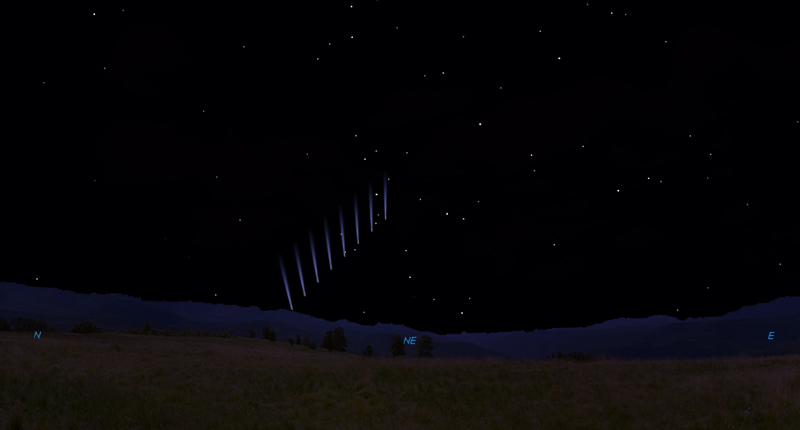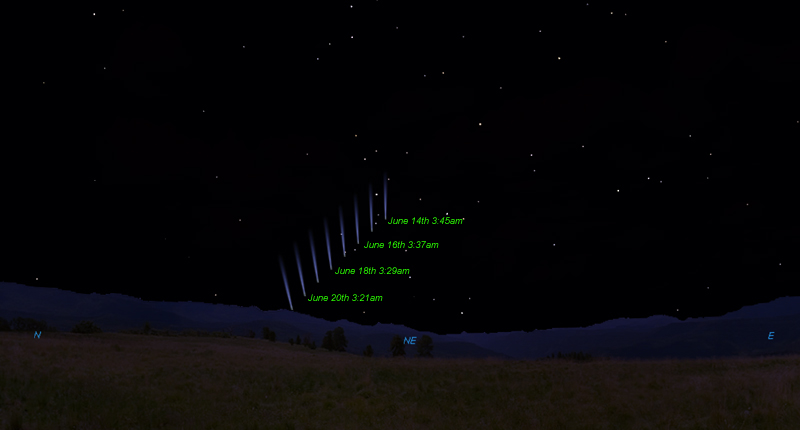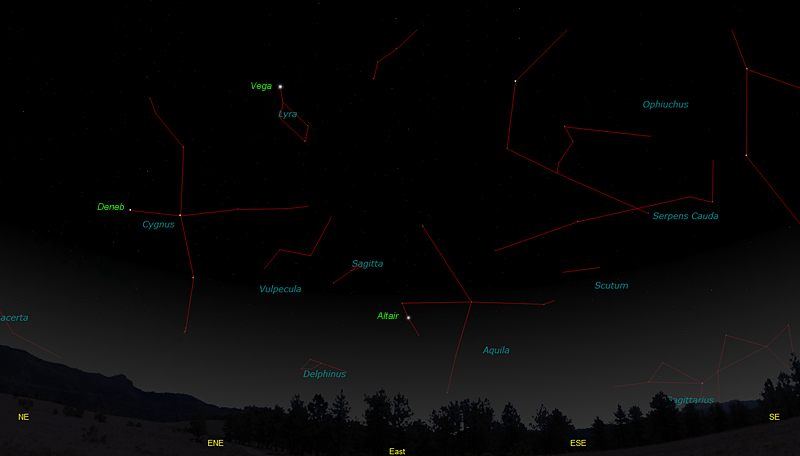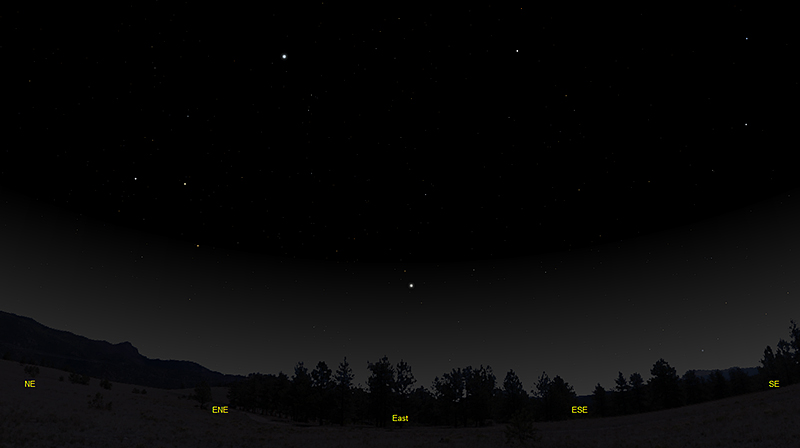The purpose of this feature is to give scout leaders, educators and naturalists an idea of some of the natural events coming up each month. We will try to cover a variety of natural events ranging from sky events to calling periods of amphibians, bird and mammal watching tips, prominent wildflowers and anything else that comes to mind. We will also note prominent constellations appearing over the eastern horizon at mid-evening each month for our area for those who would like to learn the constellations. If you have suggestions for other types of natural information you would like to see added to this calendar, let us know! Note: You can click on the hyperlinks to learn more about some of the featured items. To return to the Calendar, hit the "back" button on your browser, NOT the "back" button on the web page. All charts are available in a "printer friendly" mode, with black stars on a white background. Left clicking on each chart will take you to a printable black and white image. Please note that images on these pages are meant to be displayed at 100%. If your browser zooms into a higher magnification than that, the images may lose quality. Though we link book references to nationwide sources, we encourage you to support your local book store whenever possible. Notes and Images From May 2010
Summer brings vacations for many of us, and chances to unwind and enjoy our families and the natural world around us. We imaged this sunset at the Georgia Veterans State Park near Cordele, Georgia.
Sky Events for June 2010: The Sun is at the Summer Solstice at 6:28am CDT on June 21st, marking the beginning of summer in the Northern Hemisphere. New Comet Dawn Sky: Comet C/2009 R1 McNaught has brightened more than expected and should be visible in binoculars in the dawn sky. For a printable finder chart and more about the comet you can visit the Sky and Telescope page on the comet by clicking here. Comets can be pretty unpredictable, so it's not known how much it will brighten. Below are a couple of charts that show the position of the comet for the Middle Tennessee area on the mornings of June 14th through June 21st. The dates are shown on the lower chart, along with the Central Daylight Time. The charts show the position and orientation of the tail of the comet. The comet's brightness and color are exaggerated for clarity. Unless you have dark skies you may not be able to see the comet with the naked eye. Binoculars are highly recommended. Whether or not you can see the tail also will depend on your sky conditions. Clicking on either chart below will take you to a printable black-stars-on-white-sky version of the chart.
Evening Sky: Venus is bright and easy to see after sunset in the western sky this month. It will become visible in the twilight sky before any other star or planet. Saturn is in the southwestern sky at dusk as the month begins, about 50 degrees above the horizon. The rings are tilted only 2.1 degrees to our line of sight. The rings will not appear this thin again until the year 2024. Because of the diminished brightness of the ring system, you may be able to see fainter satellites of Saturn than you normally do with a given telescope. This is a great time to view Saturn and you will be rewarded with a stunning view in just about any telescope. At the beginning of the month, Mars will be to the lower right of Saturn at dusk. The red planet will be about 40 degrees above the western horizon and only about 2 degrees to the right of the bright star Regulus in Leo. The two are closest on June 6th, when they are less than one degree apart. Mars will be slightly brighter than Regulus, and the color contrast between the blue-white star and the reddish planet should be striking. As the month goes on the distance between the two will increase, and Mars will appear to the upper left of Regulus. Morning Sky: Jupiter rises about 1:18am at midmonth, and it's nice to it again in the dawn sky. The normally prominent south equatorial belt has faded in the last few months, and is now no longer visible. For those of us so used to seeing two dark equatorial belts, the planet looks a bit unusual. The great red spot continues to be visible.
Constellations: The views below show the sky looking east at 10:00pm CDT on June 15th. The first view shows the sky with the constellation outlined and names depicted. Star and planet names are in green. Constellation names are in blue. The second view shows the same scene without labels. New constellations this month in the eastern sky are Lyra, the Lyre, with it's bright star Vega, Cygnus, the Swan, and Aquila, the Eagle. The bright stars Vega, Deneb and Altair form the "summer triangle."
On Learning the Constellations: We advise learning a few constellations each month, and then following them through the seasons. Once you associate a particular constellation coming over the eastern horizon at a certain time of year, you may start thinking about it like an old friend, looking forward to its arrival each season. The stars in the evening scene above, for instance, will always be in the same place relative to the horizon at the same time and date each June. Of course, the planets do move slowly through the constellations, but with practice you will learn to identify them from their appearance. In particular, learn the brightest stars (like Altair and Vega in the above scene looking east), for they will guide you to the fainter stars. Once you can locate the more prominent constellations, you can "branch out" to other constellations around them. It may take you a little while to get a sense of scale, to translate what you see on the computer screen or what you see on the page of a book to what you see in the sky. Look for patterns, like the stars that make up the constellation Lyra. The earth's rotation causes the constellations to appear to move across the sky just as the sun and the moon appear to do. If you go outside earlier than the time shown on the charts, the constellations will be lower to the eastern horizon. If you observe later, they will have climbed higher. As each season progresses, the earth's motion around the sun causes the constellations to appear a little farther towards the west each night for any given time of night. If you want to see where the constellations in the above figures will be on July 15th at 10:00pm CDT, you can stay up till 12:00am CDT on June 15th and get a preview. The westward motion of the constellations is equivalent to two hours per month. Recommended: Sky & Telescope's Pocket Star Atlas is beautiful, compact star atlas. It is destined to become a classic, and is a joy to use at the telescope. A good book to learn the constellations is Patterns in the Sky, by Hewitt-White. You may also want to check out at H. A. Rey's classic, The Stars, A New Way to See Them. For skywatching tips, an inexpensive good guide is Secrets of Stargazing, by Becky Ramotowski. A good general reference book on astronomy is the Peterson
Field Guide,
A Field Guide to the Stars and Planets, by Pasachoff. The book retails for around $14.00. Starry Night has several software programs for learning the night sky. Visit the Starry Night web site at www.starrynight.com for details.
Amphibians:
In June the treefrogs really hit their stride. Listen for Cope's Gray Treefrogs, Gray Treefrogs, Bird-Voiced Treefrogs, Green Treefrogs and Barking Treefrogs. Northern Cricket Frogs and Southern Cricket Frogs call a lot during June, and the calls of Bullfrogs and Green Frogs fill the night air. After heavy rains listen for the high, insect-like call of the Eastern Narrowmouth Toad and the strange-sounding Eastern Spadefoot.
Birds: Now is a good time to get to know the breeding birds of Tennessee. It's fun to take a trip to the Great Smoky Mountains National Park in June and hike a high altitude trail, like the Alum Cave Bluff trail. By doing so you can encounter birds that breed in Tennessee at these higher elevations, like Black-throated Blue Warblers, Canada Warblers, Chestnut-sided Warblers and Blackburnian Warblers. Recommended: A new guide to hawks in flight you may want to look at is Hawks From Every Angle - How to Identify Raptors in Flight, by Jerry Liguori. The Sibley Guide to Birds, David Allen Sibley The Sibley Guide to Birds of Eastern North America, David Allen Sibley An inexpensive guide for beginners is the Golden Guide for Birds.
Archives (Remember to use the back button on your browser, NOT the back button on the web page!) Natural Calendar February 2010 Natural Calendar December 2009 Natural Calendar November 2009 Natural Calendar September 2009 Natural Calendar February 2009 Natural Calendar December 2008 Natural Calendar November 2008 Natural Calendar September 2008 Natural Calendar February 2008 Natural Calendar December 2007 Natural Calendar November 2007 Natural Calendar September 2007 Natural Calendar February 2007 Natural Calendar December 2006 Natural Calendar November 2006 Natural Calendar September 2006 Natural Calendar February 2006
Natural Calendar
December 2005
Natural Calendar
November 2005
Natural Calendar
September 2005
Natural Calendar
February 2005
Natural Calendar
December 2004
Natural Calendar
November 2004
Natural Calendar
September 2004
Natural Calendar
February 2004
Natural Calendar
December 2003
Natural Calendar
November 2003
Natural Calendar
September 2003 Natural Calendar February 2003 Natural Calendar December 2002 Natural Calendar November 2002 Nature Notes Archives: Nature Notes was a page we published in 2001 and 2002 containing our observations about everything from the northern lights display of November 2001 to frog and salamander egg masses. Night scenes prepared with The Sky Professional from Software Bisque. Comet McNaught scenes prepared with Starry Night Software. All images and recordings © 2010 Leaps |
|||||||





